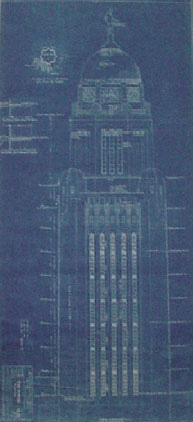
Mission Statement
Office of the Capitol Commission
Nebraska Capitol Collections OCC/NCC
Recognizing that the Office of the Capitol Commission is the main institution charged with the restoration, preservation, maintenance, and promotion of the Nebraska State Capitol building, and that the Capitol Collections are indispensable for such work, the OCC/NCC has adopted the following mission statement to define its role, and guide its efforts, in the overall program to preserve and maintain the Capitol.
The OCC/NCC exists to collect, preserve, research, and interpret objects, documentation, and information significantly related to the Capitol. The Capitol is defined as the present building and its landscape, designed by architect Bertram Grosvenor Goodhue and built from 1922 to 1932. The site is bound by 14th, 16th, H, and K streets. The Nebraska Capitol Collections consist of three separate groups: the Archival Collections, the Permanent Collections and the Circulating Collections. The Archival Collections serve as an architectural archive, designed to collect, maintain, and study documentary materials concerning the Capitol, its construction, preservation, maintenance, and history. The Circulating Collections also extend these services to natural and synthetic objects removed from service, which are elements of the Capitol’s architecture. When feasible, such objects are returned to functional use within the Capitol or its environs. The Permanent Collections exist to preserve objects permanently retired from use. These objects are used for research and reference purposes; documenting original finishes, construction techniques and other aspects important to the accurate restoration and preservation of pieces in the Circulating Collections and of the Capitol itself. The mission of the OCC/NCC is further defined as follows:
Collecting
The collections are the foundation of the OCC/NCC program. The program’s first responsibility, therefore, is to create and maintain systematic collections of objects, documentation, and information regarding the Capitol, its development, and history. The OCC/NCC focuses mainly on collecting pertinent documentation from the state institutions that are, and have been, responsible for the care of the Capitol. The OCC/NCC also focuses on collecting original components of the building which must be removed and might otherwise be lost.
The OCC/NCC will also collect objects, documentation, and information from sources outside of state government. In such cases, planning and research as required to secure and authenticate the origin and history of the material in question will occur. The OCC/NCC shall use all legal means of collecting, and shall give due consideration to all ethical matters that may arise during these pursuits.
Preservation
The second responsibility of the OCC/NCC program is to preserve the materials within its collections. Preservation of artifacts shall include appropriate storage, conservation, and cataloguing as accepted by the museum profession. Preservation of documents and related materials will include proper storage, conservation, processing, and, when applicable, reproduction as accepted by the archival profession.
Research
To a great extent, the OCC/NCC mission depends upon adequate research, which is the third responsibility of the program. The collections exist, and are preserved, in order to support the restoration, preservation, maintenance, and promotion of the Capitol. The OCC/NCC will, therefore, usually limit its research activities to one or more of these areas. Although this research will be based primarily on OCC/NCC holdings, it may also draw upon outside collections and resources as situations warrant.
Interpretation
The fourth responsibility of the program is the interpretation and promotion of the Capitol. The OCC/NCC may choose to interpret any aspect of the Capitol, its construction, and history. This may take the form of tours, presentations, publications, exhibits, and outreach programs.